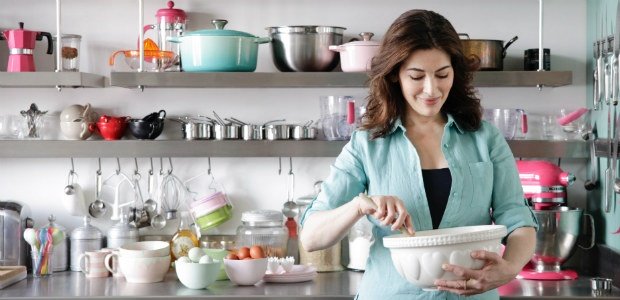(image: Nigella Lawson Facebook)
Love her or hate her, there’s simply no denying the immovable force that is Nigella Lawson. This month celebrates the 20th anniversary of her first cookbook, How to Eat, which defined Nigella as a veritable domestic goddess, as well as paving the way for a new way to look at the simple pleasure of eating. In honour of this groundbreaking book’s 20th birthday, we’re paying tribute to the book itself and of course, the one and only queen Nigella.
Her recipe-writing style
How to Eat was published at a time where cookbooks were divided into two very distinct categories, namely the “cheffy” books of Gordon Ramsay and Marco Pierre White or the very homely, and quite frumpy, writings of Delia Smith and Mary Berry. Nigella came along and used ‘handfuls’ and ‘glugs’ as measures of quantity, and this move away from perfectly-measured teaspoons taught us how to cook and critically assess for ourselves what the dish needed. There are no rules here, just guidelines for making something delicious, told in Nigella’s poetic prose.
She was not a chef
Perhaps the most endearing thing about Nigella was the fact that she wrote this book without any prior formal cooking experience. The story goes that she was a freelance journalist who simply loved to cook and host dinner parties, and this is what spurred her to write a book about her joy of eating and cooking. While I’m not advocating that every person who fancies themselves a Nigella should write a cookbook, it was significant that she wasn’t a chef. She taught us that if you take the time and care to prepare a meal for the ones you love, you’ll be able to cook as well as any chef.
The book’s distinct layout
It’s often a cause for frustration when a cookbook has no pictures – how do I know what the final dish is supposed to look like? What do they mean when they say small/big/round/flat? With How to Eat, none of these rules applied. There were no pictures of any of the food, and yet somehow it worked. This was likely owing to her Nigella-esque writing, with descriptors such as ‘unctuous’, ‘undulating’, ‘dollop’ and ‘smeared’. Her salacious choice of words was often the perfect way to describe a towering meringue with whipped cream or a hearty broth or stew. How could you mess up a syllabub when it was described as “the cool buttery flesh of a newborn baby”?
Simply put, you didn’t need pictures with her writing. In the introduction, she even says “I have wanted to make you feel that I’m there with you, in the kitchen, as you cook. The book that follows is the conversation we might be having.” And this really couldn’t be truer of How to Eat.
It taught us to cook – properly – for one
Cooking for one is often seen as a self-indulgent necessity, something thrown together out of pure desperation. However Nigella, a married mother of two at the time of writing, managed to discard that ridiculous notion by including a number of recipes scaled down to one (or perhaps two for the sole purpose of having leftovers) portion as a way of encouraging her readers to love cooking for themselves as much as they love cooking for others. She backs this up by quoting Woody Allen: “Don’t knock masturbation, it’s sex with someone I love.” which tells us everything about her views on cooking for yourself and only yourself.
Having personally cooked for myself as a way of mending a broken heart last year, I wholeheartedly agree with her on this. Not only did I show myself the purest form of love and self-care, but these practice runs made me infinitely better and more confident when the time came to cook for friends and family. It’s something that I often gift to myself even to this day, I come home and cook a proper meal for myself, just as Nigella instructed me to.
It changed the way we cook, eat and think about food
With her delicate words and clever recipes, Nigella created an iconic cookbook, but she also established an entirely new way of thinking about food and cooking. She didn’t want us to cook like chefs, she wanted us to cook like the young singletons, mothers, fathers and humans that we are. With sections that ranged from feeding babies to throwing an intimate dinner for six to those aforementioned recipes for one, she helped shape us in the cooks we all want to be – generous, relaxed and capable.
Despite these incredible recipes, the point of How to Eat isn’t about being a recipe book, as much as it is a collection of stories of food-loving family and friends. This book reminds us that food is about so much more than just sustenance, it brings people together, mends broken hearts and is cause for celebration.
Jess Spiro is a trained chef and freelance writer based in Cape Town. Follow her on Instagram!

